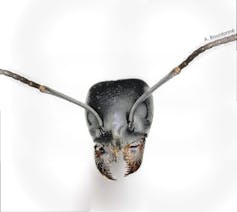What we know about "Tapinoma magnum", the shiny black ant invading Europe
Numerous invasive outbreaks of the black ant "Tapinoma magnum" have been detected in Europe. They pose no immediate health threat, but the colossal populations of each colony can cause considerable damage in urban, agricultural and even natural environments. In the hope of stemming this invasion, research is now focusing on better characterizing it, assessing its impact and exploring ways of limiting the damage.
Bernard Kaufmann, University Claude Bernard Lyon 1Alan Vergnes, University of MontpellierGiovanny Destour, University of Montpellier and Marion Javal, Institute of Research for Development (IRD)

Biological invasion refers to the introduction and proliferation of animal, plant or microbial species outside their native range. Most invasive species disrupt ecosystems by outcompeting local species and modifying habitats. They represent a growing economic burden for human societies and a threat to biodiversity.
Among these species, ants occupy a prominent place. Until now, Europe and France have been relatively spared, despite the presence of the Argentine ant Linepithema humile along the Mediterranean rim and Lasius neglectus throughout the continent. Recent alerts have raised fears of the arrival of the red fire ant(Solenopsis invicta), detected in Sicily, and the electric ant(Wasmannia auropunctata), detected twice in the Var region, two species that have caused major damage to agriculture, people and biodiversity wherever they have been imported.
But it's another species that is currently attracting attention in Western Europe: Tapinoma magnum. Numerous invasive outbreaks have been detected, with huge populations inflicting considerable damage. It is now urgent to understand its characteristics, its impact, the state of research in France, and to explore ways of limiting its damage.
The discovery of supercolonies
In 2011, researchers and naturalists in France, Germany and Italy discovered ants of the genus Tapinoma (abbreviated to T.) that were proving to be highly invasive. A European working group was quickly formed, with teams in Görlitz (Germany, B. Seifert), Rome (Italy, D. d'Eustacchio), Jaen (Spain, P. Lorite) and Lyon (France, B. Kaufmann).
At that time, only one species of the genus, T. nigerrimum, which is relatively large compared to other species of the genus (2-5 millimeters), was known in Mediterranean Europe and western North Africa, but the scientific literature does not attribute any invasive character to it. However, in the field, the colonies observed are made up of numerous nests interconnected by trails constantly frequented by workers, a dense network that can cover several hectares, constituting what are known as supercolonies, which are highly invasive.
In 2017, an analysis combining detailed morphology and genetics revealed that T. nigerrimum actually comprises at least four different species: T. nigerrimum, T darioi, T. ibericum and T. magnum.
The latter three are supercolonial and invasive species in Europe, the most common by far being T. magnum. In 2024, a fifth species is added, T. hispanicum, grouping Spanish populations of T. nigerrimum (non-invasive).
Diverse origins
As far as we know about these invasive ants, T. darioi is native to Catalonia and probably Languedoc, while T. ibericum is probably native to the rest of Spain.
For T. magnum, the situation is more complicated, with possible areas of origin covering the Maghreb states (Morocco, Algeria and Tunisia) and the whole of the Italian peninsula, perhaps as far as the Côte d'Azur in France.
Genetic analysis shows, however, that the vast majority of populations imported into non-Mediterranean regions of Europe originate from southern Italy, particularly Sicily, Calabria and Apulia. Only very rare populations have been associated with the Maghreb. In Corsica, populations seem to originate from southern Italy, with perhaps a small Algerian contribution.
Colonies covering up to 20 hectares
T. magnum and its invasive sister species are supercolonial: their numerous nests, linked by active runways, can shelter numerous queens. Built by accumulating soil to create "solariums" exposed to the heat, or installed in warm cavities, these nests optimize larval growth. Males and future queens are produced in spring (between March and May), workers later in the spring and autumn.
The supercolony is a fluid unit whose contours expand or contract according to temperature, humidity and resources, sometimes covering more than 20 hectares, unless the landscape (roads, waterways, forests) limits its expansion. The diet of invasive Tapinoma is generalist, but relies heavily on aphid honeydew, particularly on roots.
When first reported outside the Mediterranean area, the trade in Italian and Spanish century-old olive trees was quickly suspected of being the main source of invasive populations. This hypothesis was confirmed by work with plant sellers in Montpellier and Lyon, which showed that many of them were harboring one or more invasive Tapinoma species, often fromdifferent geographical origins.
However, recent observations point to other potential transport vectors: cars in which the ants climb during the day to find high temperatures, transport of green waste, movement of ornamental plants for events or even transport of prefabricated buildings.
Black, shiny and very fast
Invasive Tapinoma ants are easy to recognize in the field: they are black, shiny, extremely fast ants whose workers, within the same colony, vary in size from 2mm to 5mm.

When crushed, they have a characteristic odor, described by ancient writers as reminiscent of rancid butter. This diagnosis is not enough. T. nigerrimum, indigenous and unproblematic, has the same characteristics, and other smaller species(T. erraticum, T. subboreale, T. madeirense) have the same odor.
To be sure you're looking at an invasive Tapinoma, you need to be able to observe several nests linked by ant trails.
Distinguishing between the three invasive species requires more genetic, chemical and imaging resources deployed by our laboratories.
Urban and agricultural damage
The first thing to remember is that Tapinoma, while annoying, present no proven health risk, except for very young children in direct contact with crowded nests.
However, invasive Tapinoma cause damage in natural environments as well as in urban or agricultural areas, with direct or indirect negative effects on biodiversity that have not yet been quantified, but are probably significant.

In market gardening and home gardens, ants destroy vast quantities of soil, denuding roots and burying stems. They cut leaves and stems, breed aphids en masse, and attack certain vegetables. Business losses can be substantial, especially in greenhouses: in the Drôme region, for example, an organic market gardener saw two-thirds of his sales cut.
For companies, the massive presence of ants found in manufactured and exported objects can lead to their rejection or return, and in the catering trade, they can contaminate kitchens or drive customers away from terraces. Green spaces departments have noted an effect on the number of visitors to the most overgrown areas of parks, on the use of shared gardens in Lyon and on production greenhouses in Grenoble.
We expect these species to spread rapidly throughout the country, and their impacts to multiply. Unlike other invasive species such as the Argentine ant and Lasius neglectus, Tapinoma are highly adaptable, particularly as they have been imported from several regions on multiple occasions, and therefore present a high degree of genetic diversity. Their ability to establish themselves anywhere in the country is greatly enhanced by climate change.
Several research groups, of which we are a part, are currently working to better understand these species and propose control strategies, working in networks with local players, associations and local authorities. In our laboratories in Lyon (B. Kaufmann), Avignon(IMBE), Montpellier(CEFE, CBGP) and Tours(IRBI), we are studying their dispersal and proliferation mechanisms, their genetics and ecology, and working on control methods. Our research should lead to the development of a control strategy and tools over the next two years.
What should you do if you suspect a home invasion?
For individuals faced with the suspicion of Tapinoma, here is some advice:
- First of all, you need to be sure that it's an invasive Tapinoma, and have the species identified by a specialist by contacting the FIVALO project for the Centre region, or Bernard Kaufmann for the rest of the country. This is vital to avoid harming local ant species, which are the first barrier against invasion. This is particularly the case in the southern half of France, where the local species T. nigerrimum is present.
- Then contact your neighbors to find out if they are affected too, so you can act together later,
- and then its municipality or intercommunal body by means of a letter signed by all the residents concerned.
So start fighting back. There's no need to call in exterminators, unless the invasion is limited to one or two houses or gardens, but follow three simple principles.
- First, look for nests (in spring and autumn) either in the ground or in objects in the garden (dry compost, flower pots, planters, under tiles, flagstones, stones, metal, garden tarpaulin) or along the house (stairs, boiler room or laundry room, attic).
- Secondly, destroy them if possible by drowning them in hot water (60°C) or large quantities of sprinkling water (in this case, renew frequently); if impossible, physically disturb them with a spade and remove favorable sites.
- The third is to attract ants to improvised "trap" nests: any of the garden objects listed can be used as a trap. In spring, ants breed their future queens, who need warmth and therefore sunlight. This is the time to eliminate them, to limit the number of reproducers the following season.
For businesses, professionals and local authorities: the procedures explained above are too labor-intensive to be sustainable, so there are no turnkey solutions for the time being. That's why we need to take preventive action, particularly for green space departments and landscapers.
Essential precautions include checking that ants are not present in green spaces, buildings or garbage dumps in the area or company; inspecting plants chosen for green spaces or interior fittings; monitoring the transport of green waste or compost; and limiting the presence of ants in parking lots, where they could climb into vehicles. Don't hesitate to contact the laboratories for advice.
Bernard Kaufmann, Senior Lecturer in Ecology, Université Claude Bernard Lyon 1Alan Vergnes, Researcher, University of MontpellierGiovanny Destour, Researcher, University of Montpellier and Marion Javal, Researcher, Institute of Research for Development (IRD)
This article is republished from The Conversation under a Creative Commons license. Read theoriginal article.